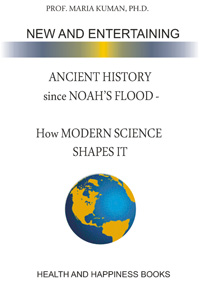
T
his book will help you better understand who you are. It describes how studies of mitochondrial DNA and study of the glaciers from modern science are combined with archeological, anthropological, linguistic studies, and ancient text to reveal the genetic origin of the Caucasians and many other tribes they mixed with: Aryans, Mongolians, Dravidians, Africans, and others. The book reveals the origin of the European: Slaves, Romans, Saxons, Franks, the Asian: Tatars, Koreans, Japanese, Chinese, Indians, and the African Ethiopians.
 Evidence is provided that ethnic origin Caucasian means descendants of Noah, who settled in the Caucasus Mountains 9,500 years ago after Noah's Flood, and mixed with local Aryan tribes who survived the flood high in the mountains (Herodotus). Later, as they multiplied, they spread around the Black Sea and further mixed with local Aryans. However, local sea flood of about 5000 B.C. displaced these Caucasian mixed with Aryan tribes and they spread all over Europe and Asia.
When the tribes living in Asia started moving back to Europe about 5,000 years later, the Greeks called them 'Kelti,' which in Greek means 'Strangers,' while the Romans called them 'Galli,' which in Latin means 'Strangers.'
Evidence is provided that ethnic origin Caucasian means descendants of Noah, who settled in the Caucasus Mountains 9,500 years ago after Noah's Flood, and mixed with local Aryan tribes who survived the flood high in the mountains (Herodotus). Later, as they multiplied, they spread around the Black Sea and further mixed with local Aryans. However, local sea flood of about 5000 B.C. displaced these Caucasian mixed with Aryan tribes and they spread all over Europe and Asia.
When the tribes living in Asia started moving back to Europe about 5,000 years later, the Greeks called them 'Kelti,' which in Greek means 'Strangers,' while the Romans called them 'Galli,' which in Latin means 'Strangers.'
This makes the Caucasus Mountains, Asia Minor, and the Balkans the cradle of our civilization. The book reveals the origin of the Romans, the Trojans, the Greeks, the Aryans, etc. by going back all the way to Noah and beyond. If you know which part of Europe or Asia your ancestors were from, you will know their history since Noah's Flood.
